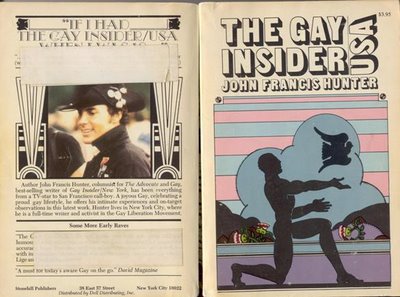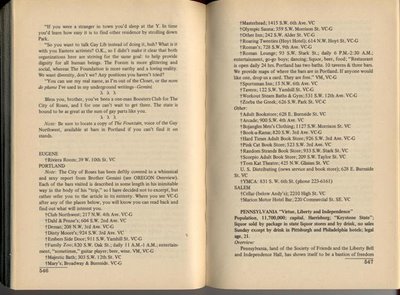A gay guide book The Gay Insider USA was sold in bookstores across America in 1972. It included a national listing of gay bars and State laws against homosexual behavior, such as a Eugene gay bar and the law against sodomy in Oregon. Consistent with societal homophobia at that time, the author's name listed on the cover, John Francis Hunter, was a pseudonym and it isn't until page 60 that the author revealed his real name, John Paul Hudson, perhaps to be more true to the 1970's gay liberationist's goal of being out of the closet. (See previous post The Gay Insider USA 1972 (9/15/06))
PHOTO: (click photo to enlarge) Oregon State University, located in the small college town of Corvallis, Oregon has never been large enough to support a dedicated gay bar, but the slightly larger college town south of it, Eugene, Oregon, home of the University of Oregon, had a gay bar early as 1972 that was named the Riviera Room at 39 W. 10th, which was listed on pages 546-547 of a popular guide book by by John Francis Hunter, "The Gay Insider USA," Stonehill 1972. (See previous posts The Gay Insider USA 1972 (9/15/06) and New gay bar mentioned on Eugene TV news station (7/20/15)
A New York City gay newspaper story covered the closing of a NYC gay bar and one writer commented:
" A spate of articles has appeared lately on the subject of gay bars shutting down, and strangely, they all conclude that it's A Good Thing. In the last two weeks, the Chicago Tribune, The Economist, and the website The Good Men Project have all published articles that examine the trend . . .
It takes a few paragraphs to get there, but the Trib finally gets to the fundamental reason that gay bars are disappearing: "'It all changed with smartphones,' LaFary said, referring to the widely held theory that mobile dating apps like Grindr, by facilitating meetups online, helped render bars unnecessary. . ."
(Quoted from Ed Sikov, "A Gay Walks into a Bar -- Ow!" gaycitynews.nyc posted January 5, 2017)
I vividly recall going to my first gay bar in Downtown Minneapolis shortly after reading about the 1969 Stonewall riot in the NYC Village Voice newspaper my mother subscribed to, which taught me that gay bars were where gay people met to socialize and hookup. I was directed to a bar named "Suttons" by a friendly dormitory Resident Assistant who offered to take me there. The RA patiently explained to me the social customs and I remember being terrified by all of the drunken "old men" lecherously leering at me, who I later learned viewed me as being a young "twink" or "chicken" who was probably a virgin and not of the legal age required to be in a bar.
Personally, I was never turned on by the gay bar scene, even though I admit to being curious when I lived in San Francisco, and so when I moved to Corvallis, Oregon State University, and learned that the nearest gay bars were more than an hour drive away, I was glad to become part of creating an alternative place to meet other gay people on campus in the OSU Women's Center, which had been created in 1972. Likewise, I soon learned how Corvallis was like many small towns where all types of people, loggers, farmers, college professors, etc., intermixed in all of the local social gathering spots, something that is apparently happening everywhere today according to Gay City News. For example, the Corvallis bar named "Squirrels" that was open in the 1970's and it is still in business today, was popular with both straight and gay students.
Also, I was never into cruising public parks or tearooms to hook up for sex. See my previous posts Student paper features 'cruising spot' at Oregon State University (4/20/12) and OSU gay lifestyles 1984 (7/232/06) that quotes an OSU student in 1984 saying that one particular gay guide, in years past, listed only two places where gay people could meet other gays in Corvallis, and those, Eddie says, were "two of the bathrooms on campus." [Note: Besides the bushes along the then overgrown riverfront, the sixth floor library bathroom and two MU bathrooms (MU Ballroom and 3rd floor) were both frequented by "gay cruisers." These toilet rooms were known as "tearooms" (or t-rooms) and they were documented by the sociologist Laud Humphreys in his scholarly book titled, "Tearoom Trade" (1970).
Gay bars, tearooms and public parks might not be used as much to hookup by gay men today, except for gay men who have a fetish for these types of places or who don't own a smartphone, and this might be a "good thing" or a "sign of progress" for gay men, but it raises some new sociological questions for a young researcher at OSU: What are the gay social customs in smartphone apps and on social media? Are their gay ghettos online today that have similar social issues that gay bars and tearooms had in the past, or have gay apps and social media created some new social issues for gay men? These questions are just off the top of my mind and I will leave it to a young OSU student to research it and formulate a better set of questions and answers.

